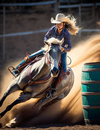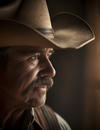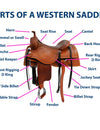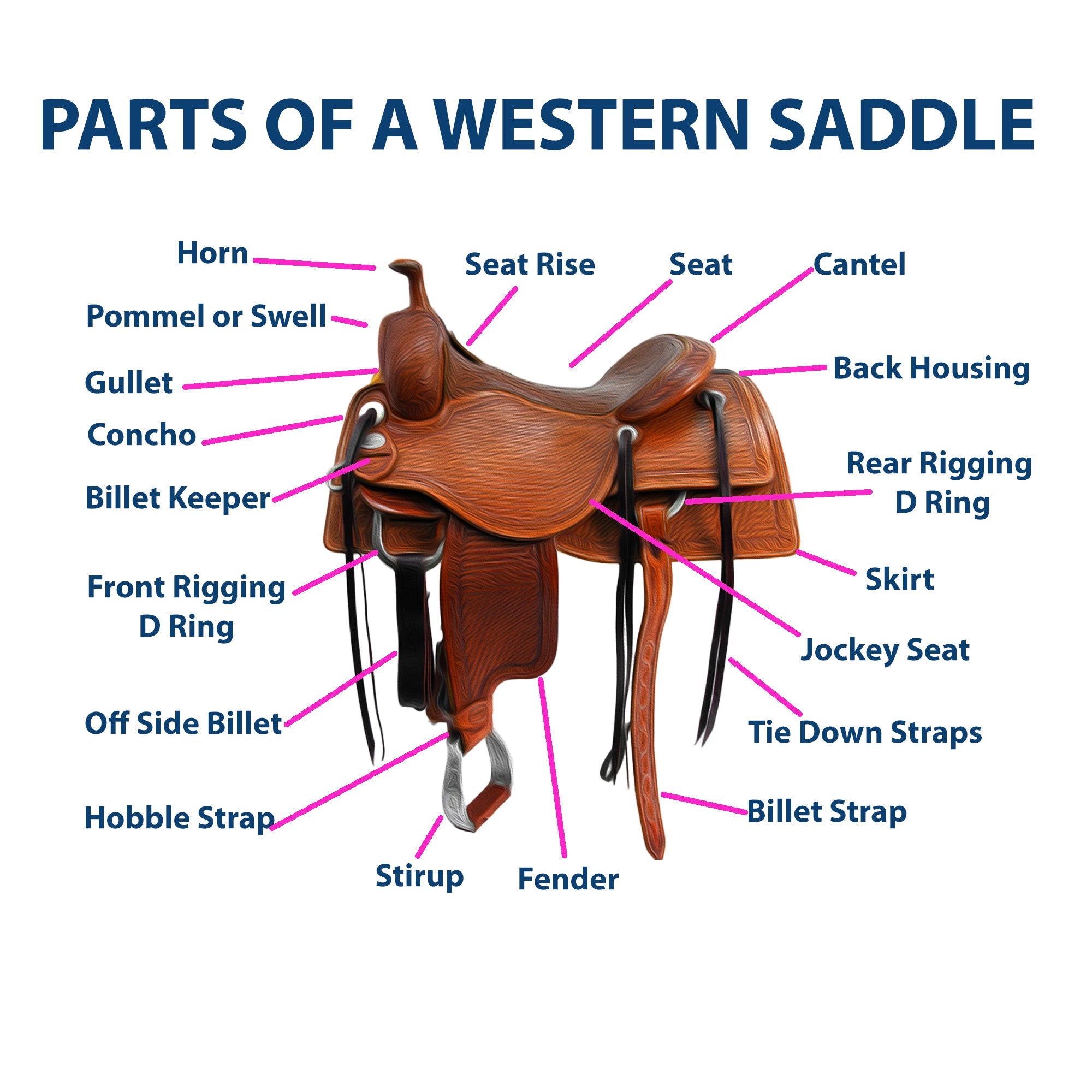
Parts of a Western Saddle
The western saddle is an iconic symbol of the American West and has been used by cowboys and riders for generations. With its intricate leatherwork, intricate metalwork and variety of shapes and sizes, the western saddle is a unique and beautiful piece of art. But beyond its aesthetic appeal, the western saddle is also a very functional tool for horseback riding. Knowing the different parts of a western saddle and their uses is essential for any aspiring rider. This comprehensive guide will explain the different components of a western saddle and their purposes, so you can be better prepared for your next ride.
Anatomy and parts of a Western Saddle
The western saddle is composed of five main parts: the tree, the bars, the pommel, the cantle, and the horn. The tree is a wooden frame that serves as the base of the saddle, providing support and stability while in use. The bars are metal strips that connect to each side of the tree and provide additional support. The pommel is located at the front of the saddle and provides a place for riders to hold onto when mounting or dismounting. The cantle is located at the back of the saddle and provides additional comfort for riders. Finally, there’s the horn – a common feature on most western saddles – which provides an easy handle for riders to hold onto while riding.
1. Saddle Tree
A saddle tree is the structural foundation of a western saddle. It is the base upon which the rest of the saddle is built and provides the shape and support for the entire saddle.
The tree is typically made of wood or synthetic materials, with wood being the traditional choice. The wood used in the manufacturing of saddle tree is typically white wood or rawhide. Rawhide is a type of leather that is made from the hide of a cow, and is known for its strength and durability. White wood, on the other hand, is a type of wood that is light in color and is known for its flexibility and strength.
The tree is designed to provide a secure and comfortable fit for the horse, and to distribute the rider's weight evenly across the horse's back. The shape of the tree is critical to the overall fit of the saddle, and is determined by the horse's back shape, withers, and shoulder. A well-fitted tree will allow for a full range of movement for the horse and will not put pressure on any one area of the horse's back.
The tree is usually composed of two parts: the fork and the cantle. The fork is the front part of the tree, and is designed to fit around the horse's withers, the highest point of the horse's shoulder. It is typically lower than the cantle, which is the back part of the tree, and provides additional support and security for the rider.
The rigging is attached to the tree, typically through rings, which are also part of the tree. These rings are usually made of metal and are used to attach the girth and breast collar, which helps to keep the saddle in place on the horse's back.
In summary, a saddle tree is the structural foundation of a western saddle, providing the shape and support for the entire saddle. It is usually made of wood or synthetic materials and is designed to provide a secure and comfortable fit for the horse. The tree is composed of two parts, the fork and the cantle, which are designed to fit around the horse's withers and provide additional support for the rider. The rigging is attached to the tree via rings, which are used to secure the saddle to the horse's back.
1. The Gullet
The gullet is the area between the front and back of the saddle. It is designed to provide clearance for the horse's spine and withers, allowing the rider to sit comfortably in the saddle. The size of the gullet depends on the breed of horse as some horses have wider backs than others. Gullets can vary in width from narrow to extra wide, so it’s important to know what type of horse you’ll be riding before purchasing a western saddle. For example, if you plan on riding an Arabian or Mustang, you'll need a narrower gullet than if you were riding a Quarter Horse or Paint Horse.
2. The Cantle
The cantle is the back of the saddle, located behind the rider’s seat. It is typically higher than other parts of the saddle and provides protection against hitting your back when you ride at high speeds or over rough terrain. The cantle also helps to keep the rider in a safe and comfortable position while riding. Some western saddles also feature a horn on top of the cantle, which allows riders to tie and secure objects like ropes or lassos securely.
3. The Skirt
The skirt is one of the most visually striking parts of a western saddle. It is made of leather or suede and hangs down from the seat of the saddle to provide stability and protection against wear and tear. The skirts also helps to keep the rider in place while riding, as they can press firmly against the sides of the horse when necessary. They are often decorated with intricate tooling, such as floral patterns or geometric designs. The skirts also have a very practical purpose: they help to reduce pressure on the horse’s back caused by the weight of the rider.
4. The Fenders
The fenders, or stirrups, are the two leather loops that attach to either side of the saddle. They provide a place to rest your feet while riding and help keep your legs in place. The length of the fenders can be adjusted by tightening or loosening the buckles that attach them to the saddle. It's important for the fenders to be adjusted correctly so your legs are properly positioned for riding. The fenders should be slightly forward of your hips, allowing you to maintain balance and control on horseback. Properly fitting stirrups will also reduce fatigue in your legs over longer rides.
5. The Stirrups
The stirrups on a western saddle provide the rider with balance and support while riding. They are typically made of metal or leather, and come in various sizes for different riders. The stirrups should be positioned correctly for the rider’s comfort and safety, as they can contribute to an uncomfortable ride if set too low or too high. It is important to check that the stirrup leathers are properly adjusted so that they can be easily adjusted while riding. When riding in a western saddle, the stirrups should be placed at hip level, with the heel slightly lower than the toe to ensure proper posture and balance.
6. The Horn
The horn is one of the most recognizable parts of a western saddle. It is found on the front of the saddle and protrudes up from the seat. The horn is used to help secure the rider’s grip on the saddle, allowing them to stay in place while riding. It can also be used as a handhold when mounting or dismounting, and as an anchor point for tying objects such as reins or lariats. The size and shape of a western saddle’s horn can vary, but all horns are designed to provide extra grip and stability for riders.
7. The Rigging
The rigging is the part of the saddle that attaches to the girth and holds it in place. The two main types of rigging are traditional, which uses a single cinch, and full-rigged, which has two cinches. The purpose of the rigging is to provide stability for the rider and allow them to move freely with their horse’s movements. The type of rigging you choose should be based on your riding style and preference.
Leave a comment

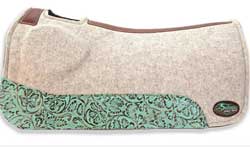 OrthoRide™ Saddle Pads
OrthoRide™ Saddle Pads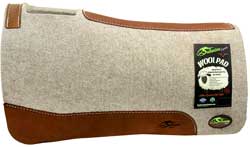 Wool Saddle Pads
Wool Saddle Pads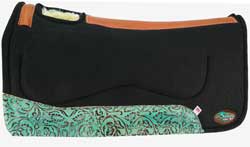 Discipline
Discipline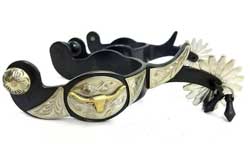 Tack
Tack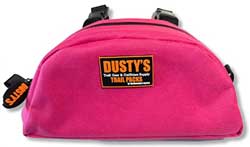 Cool Stuff
Cool Stuff